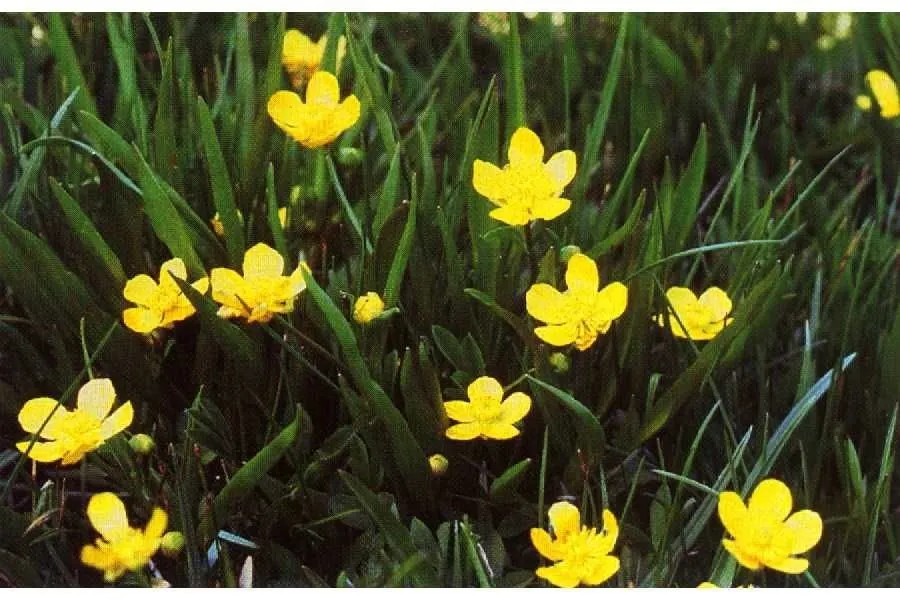
Author: Geyer ex Benth.
Bibliography: “Pl. hartw. 295. 1849 “”alismaefolius“””
Year: 1849
Status: accepted
Rank: species
Genus: Ranunculus
Vegetable: False
Observations: SW. British Columbia to NW. Mexico
The plant known as the Plantainleaf buttercup, scientifically named Ranunculus alismifolius, belongs to the family Ranunculaceae. This perennial herb is a remarkable species found in diverse regions stretching southwest from British Columbia down to northwest Mexico. Initially chronicled by Geyer ex Benth., it was officially documented in 1849 under the title “Pl. hartw. 295.” The scientific name alismaefolius reflects the plant’s characteristic broad, plantain-like leaves.
The Plantainleaf buttercup typically inhabits moist environments such as wetlands, meadows, and along stream banks. This environmental preference mirrors the broader habitat tendencies of the Ranunculaceae family, which is known for thriving in cool, moist conditions. The plant is especially noted for its resilience and capacity to proliferate in varied climatic zones within its geographical range.
A distinguishing feature of Ranunculus alismifolius is its glossy, yellow buttercup-like flowers, which provide a splash of color in its native habitats. This distinctive flowering aspect not only enhances the visual appeal of natural landscapes but also plays a vital role in local ecosystems by supporting pollinators including bees and butterflies. Additionally, the plantain-shaped leaves are not just a defining feature but also a practical adaptation that aids the plant in maximizing photosynthesis and water uptake.
In terms of botanical structure, the Plantainleaf buttercup typically emerges with a height that can range from a few inches to over a foot, depending on environmental conditions. The stems are often erect, supporting the radiant, sun-catching flowers that blossom in the spring and early summer.
Understanding the ecological importance and botanical characteristics of Ranunculus alismifolius is crucial for conservation efforts and for appreciating the biodiversity of the regions it inhabits. Whether observed in the wild or studied for academic and horticultural purposes, the Plantainleaf buttercup remains an enduring specimen of interest due to its distinct appearance and adaptive capabilities.
Eng: plantainleaf buttercup, water-plantain buttercup, plantain-leaved buttercup
Fra: renoncule à feuilles d’alisme
En: Plantainleaf buttercup, Water-plantain buttercup, Plantain-leaved buttercup
Fr: Renoncule à feuilles d’alisme
Taken Apr 12, 2009 by EOL − Keir Morse (cc-by-nc-sa)
Taken Feb 26, 2011 by EOL − Ryan Batten (cc-by-nc-sa)
Taken Jan 1, 1900 by EOL − Cooper, G.A. (cc-by-nc-sa)
Taken Oct 16, 1998 by EOL − Charles Webber (cc-by-nc-sa)
Taken Mar 9, 2013 by EOL − Gary A. Monroe (cc-by-nc)
Taken Jan 1, 1900 by EOL − USDA NRCS Wetland Science Institute. (public)
Taken Nov 22, 1999 by EOL − William R. Hewlett (cc-by-nc-sa)
Taken Feb 24, 1999 by EOL − Gladys Lucille Smith (cc-by-nc-sa)
Taken Aug 18, 2005 by EOL − J. E.(Jed) and Bonnie McClellan (cc-by-nc-sa)
Taken Mar 9, 2013 by EOL − Gary A. Monroe (cc-by-nc)
Taken Sep 7, 2008 by EOL − Steve Matson (cc-by-nc)
Taken Apr 12, 2009 by EOL − Keir Morse (cc-by-nc-sa)
Growth form>: Single Crown
Growth habit>: Forb/herb
Growth rate>: Moderate
Ph maximum: 7.5
Ph minimum: 6.0
Family: Myrtaceae Author: (F.Muell.) K.D.Hill & L.A.S.Johnson Bibliography: Telopea 6: 402 (1995) Year: 1995 Status:…
Family: Rubiaceae Author: Pierre ex A.Froehner Bibliography: Notizbl. Bot. Gart. Berlin-Dahlem 1: 237 (1897) Year:…
Family: Sapindaceae Author: Koidz. Bibliography: J. Coll. Sci. Imp. Univ. Tokyo 32(1): 38 (1911) Year:…
Family: Asteraceae Author: A.Gray Bibliography: Pacif. Railr. Rep.: 107 (1857) Year: 1857 Status: accepted Rank:…
Family: Fabaceae Author: Medik. Bibliography: Vorles. Churpfälz. Phys.-Ökon. Ges. 2: 398 (1787) Year: 1787 Status:…
Family: Aspleniaceae Author: (Cav.) Alston Bibliography: Bull. Misc. Inform. Kew 1932: 309 (1932) Year: 1932…